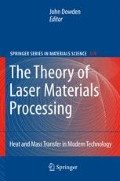Abstract
For laser welding and for laser hardening the resulting mechanical properties of the product can be expressed by the shape and metallurgy of the processed cross section. Both are determined by heat conduction, in particular by resolidification, by diffusion and by the crystallographic material behaviour, governed by the local thermal cycle of the material. In the following, a brief survey on the physical mechanisms responsible for the metallurgy [1, 2] at the macro- and micro-scale will be given, mainly referring to ferritic low alloy steel as the most relevant material. Many aspects are relevant to both welding and hardening, while some aspects are process-specific. For certain phenomena selected mathematical models are presented that enable quantitative calculation and description of the phenomena.
The notation employed in this chapter is to be found in Table 7.1.
Access this chapter
Tax calculation will be finalised at checkout
Purchases are for personal use only
Preview
Unable to display preview. Download preview PDF.
References
Bengtsson B, Li W-B, Easterling K E (1983) Phase transformation in solids, Tsakalakos Th (ed), New York
Shewman PG (1963) Diffusion in solids. McGraw-Hill, New York
Lampa C, Kaplan AFH, Powell J, Magnusson C (1997) Fluid flow and resolidification in deep penetration laser welding. Lasers in Engineering 7: 241–252
Ploshikhin VV, Bergmann HW (1999) Influence of the process parameters on the grain structure in welds with a constant fusion zone width. Lasers in Engineering 8: 285–294
Hao S, Liu WK, Moran B, Vernerey F, Olson GB (2004) Multi-scale constitutive model and computational framework for the design of ultra-high strength high toughness steels. Comput Meth Appl Mech Eng 193: 1865–1908
Gould JF, Khurana SP, Li T (2006) Predictions of microstructures when welding automotive advanced high strength steel. Weld J 85: 111s–116s
Nishimoto K, Mori H (2004) Hot cracking susceptibility in laser weld metal of high nitrogen stainless steel. Sci Techn Adv Mat 5: 231–240
Ashby MF, Easterling KE (1984) The transformation hardening of steel surfaces by laser beams – I. hypo-eutectoid steels. Acta metall 32(11): 1935–1948
Li W-B, Easterling KE, Ashby MF (1986) Laser transformation hardening of steel – II. hypereutectoid steels. Acta metall 34(8): 1533–1543
Wouters M, Powell J, Kaplan AFH (2006) The influence of the joint gap on the strength of hybrid Nd:YAG laser-MIG welds, Journal of Laser Applications 18(3): 181–184
Young WC (2002) Roark’s formulas for stress and strain. 7th edition, McGraw- Hill, New York
Mackerle J (2002) Finite element analysis and simulation of welding – an addendum: a bibliography (1996–2001). Mod Simul Mat Sci Eng 10: 295–318
Kaplan AFH, Nilsson K, Powell J (2007) Shaping of hybrid welds and gap sensitivity. Proceedings LIM – Lasers in Manufacturing, Munich (D), Vollertsen F (ed), 73–77
Prahl U, Papaefthymiou S, Uthaisansuk V, Bleck W, Sietsma J, van der Zwaag S (2007) Micromechanics-based modelling of properties and failure of multiphase steels. Comp Mat Sci 39: 17–22
Katayama S, Matsunawa A, Kojima K (1999) CO2 laser weldability of aluminium alloys (2nd report): defect formation conditions and causes. Welding Research Abroad 45(6–7): 44–59
Kaplan AFH, Mizutani M, Katayama S, Matsunawa A (2002) Unbounded keyhole collapse and bubble formation during pulsed laser interaction with liquid zinc. J Phys D: Appl Phys 35: 1218–1228
Kaplan AFH, Mizutani M, Katayama S, Matsunawa A (2002) Analysis of different methods for the prevention of pore formation in keyhole laser spot welding. Welding in the World (Special Issue) 46: 39–50
Kaplan AFH, Mizutani M, Katayama S, Matsunawa A (2002) Keyhole laser spot welding. Proc. ICALEO 2002, Scottsdale (AR), Laser Institute of America, Orlando (FL)
Kaplan AFH, Mizutani M, Katayama S, Matsunawa A (2002) On the mechanism of pore formation during keyhole laser spot welding. Proc LAMP 2002, Osaka (JAP), Osaka University, Osaka (JAP)
Author information
Authors and Affiliations
Editor information
Editors and Affiliations
Rights and permissions
Copyright information
© 2009 Canopus Academic Publishing Limited
About this chapter
Cite this chapter
Kaplan, A. (2009). Metallurgy of Welding and Hardening. In: Dowden, J. (eds) The Theory of Laser Materials Processing. Springer Series in Materials Science, vol 119. Springer, Dordrecht. https://doi.org/10.1007/978-1-4020-9340-1_7
Download citation
DOI: https://doi.org/10.1007/978-1-4020-9340-1_7
Publisher Name: Springer, Dordrecht
Print ISBN: 978-1-4020-9339-5
Online ISBN: 978-1-4020-9340-1
eBook Packages: Physics and AstronomyPhysics and Astronomy (R0)

